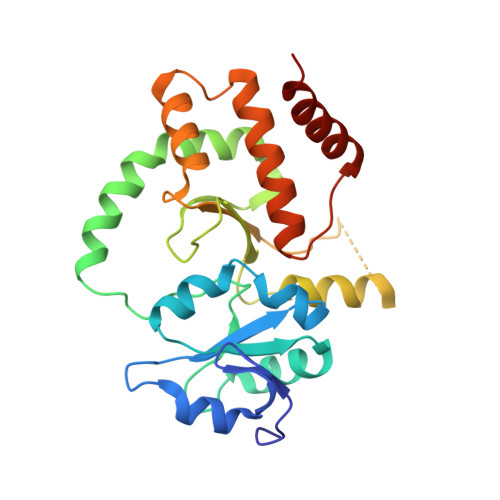The Crystal Structure of the Hsp90-LA1011 Complex and the Mechanism by Which LA1011 May Improve the Prognosis of Alzheimer's Disease.
Roe, S.M., Torok, Z., McGown, A., Horvath, I., Spencer, J., Pazmany, T., Vigh, L., Prodromou, C.(2023) Biomolecules 13
- PubMed: 37509087
- DOI: https://doi.org/10.3390/biom13071051
- Primary Citation of Related Structures:
8OXU - PubMed Abstract:
Functional changes in chaperone systems play a major role in the decline of cognition and contribute to neurological pathologies, such as Alzheimer's disease (AD). While such a decline may occur naturally with age or with stress or trauma, the mechanisms involved have remained elusive. The current models suggest that amyloid-β (Aβ) plaque formation leads to the hyperphosphorylation of tau by a Hsp90-dependent process that triggers tau neurofibrillary tangle formation and neurotoxicity. Several co-chaperones of Hsp90 can influence the phosphorylation of tau, including FKBP51, FKBP52 and PP5. In particular, elevated levels of FKBP51 occur with age and stress and are further elevated in AD. Recently, the dihydropyridine LA1011 was shown to reduce tau pathology and amyloid plaque formation in transgenic AD mice, probably through its interaction with Hsp90, although the precise mode of action is currently unknown. Here, we present a co-crystal structure of LA1011 in complex with a fragment of Hsp90. We show that LA1011 can disrupt the binding of FKBP51, which might help to rebalance the Hsp90-FKBP51 chaperone machinery and provide a favourable prognosis towards AD. However, without direct evidence, we cannot completely rule out effects on other Hsp90-co-chaprone complexes and the mechanisms they are involved in, including effects on Hsp90 client proteins. Nonetheless, it is highly significant that LA1011 showed promise in our previous AD mouse models, as AD is generally a disease affecting older patients, where slowing of disease progression could result in AD no longer being life limiting. The clinical value of LA1011 and its possible derivatives thereof remains to be seen.
- Department of Biochemistry and Biomedicine, University of Sussex, Brighton BN1 9QG, UK.
Organizational Affiliation:

















